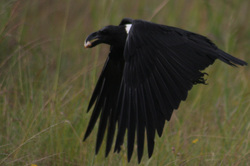Crows and Ravens
African White-Necked Raven
Size:
White necked (also known as White-naped) raven is the largest and the most impressive of the seven species of East African corvids.
At 20 inches tall with a 3 foot wingspan, the white-necked raven is a large bird. In their native region of Africa (eastern edge of the continent from South Africa to Zaire), they are often mistaken for hawks.
Average Lifespan:
25-50 years.
Temperament:
Like ravens worldwide, they are famous for their intelligence and frequently found playing the role of "trickster" in native mythology.
They often show a playful side and can frequently be spotted indulging in aerial acrobatics. Where they are found around human habitation they are frequently quite tame. All Ravens are intelligent, inquisitive, generally friendly birds. Ravens can easily be taught human speech and can learn how to count.
The only species that bears any resemblance to the White-necked Raven is the Pied Crow which is smaller and has a white breast. However the simple rule "if you have to ask, it's not a raven" applies. Once you have seen this impressive bird you're unlikely to ever confuse it again!
Colors:
The entire body portraits deep blue-purple iridescence to their feathers with a very distinct large white patch at the back of its neck and an ivory tip on its dark bill.
Feeding:
Ravens are omnivorous. They will eat anything which is edible (and many things which aren't). Their usual diet contains insects, seeds, berries, carrion (the bodies of animals killed by creatures other than the raven), the eggs and young of other birds, and occasionally small mammals.
Exercise:
Raven are very active birds. They love to hop, fly, and peck at items. Those who own this type of bird should provide a minimum of 4 to 6 hours of playtime outdoors daily. The flight cage should be large enough for them to fly, stretch and exercise their muscles. The outdoors is also very important for them to receive the necessary vitamin D from the sun for the well-being and strength/density of their bones.
Always remember to remove the anklets or leg restraints while your bird is in the flight cage, as they can get caught up on objects and could injure themselves. Vet wrap can be used on the perches to ensure the perches are easy on their feet, varying sized perches are always a good idea too.
Toys and enrichment items are important for stimulation. As we mentioned, they are the smartest birds in the world and need mental & physical stimulation to remain happy and healthy pets.
White necked (also known as White-naped) raven is the largest and the most impressive of the seven species of East African corvids.
At 20 inches tall with a 3 foot wingspan, the white-necked raven is a large bird. In their native region of Africa (eastern edge of the continent from South Africa to Zaire), they are often mistaken for hawks.
Average Lifespan:
25-50 years.
Temperament:
Like ravens worldwide, they are famous for their intelligence and frequently found playing the role of "trickster" in native mythology.
They often show a playful side and can frequently be spotted indulging in aerial acrobatics. Where they are found around human habitation they are frequently quite tame. All Ravens are intelligent, inquisitive, generally friendly birds. Ravens can easily be taught human speech and can learn how to count.
The only species that bears any resemblance to the White-necked Raven is the Pied Crow which is smaller and has a white breast. However the simple rule "if you have to ask, it's not a raven" applies. Once you have seen this impressive bird you're unlikely to ever confuse it again!
Colors:
The entire body portraits deep blue-purple iridescence to their feathers with a very distinct large white patch at the back of its neck and an ivory tip on its dark bill.
Feeding:
Ravens are omnivorous. They will eat anything which is edible (and many things which aren't). Their usual diet contains insects, seeds, berries, carrion (the bodies of animals killed by creatures other than the raven), the eggs and young of other birds, and occasionally small mammals.
Exercise:
Raven are very active birds. They love to hop, fly, and peck at items. Those who own this type of bird should provide a minimum of 4 to 6 hours of playtime outdoors daily. The flight cage should be large enough for them to fly, stretch and exercise their muscles. The outdoors is also very important for them to receive the necessary vitamin D from the sun for the well-being and strength/density of their bones.
Always remember to remove the anklets or leg restraints while your bird is in the flight cage, as they can get caught up on objects and could injure themselves. Vet wrap can be used on the perches to ensure the perches are easy on their feet, varying sized perches are always a good idea too.
Toys and enrichment items are important for stimulation. As we mentioned, they are the smartest birds in the world and need mental & physical stimulation to remain happy and healthy pets.

